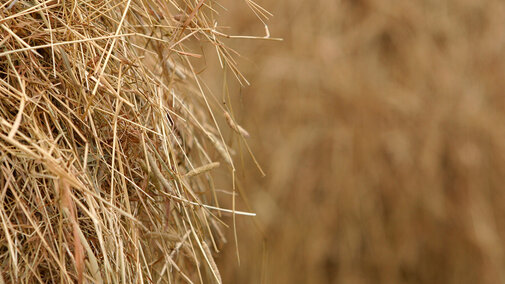Saving Hay
Making, transporting and feeding hay is a large investment in time, equipment and money. At current prices, even reducing waste a small amount can mean big savings. Can you be doing more to save hay?
While there will always be some loss during storage, keeping hay out of the elements and packed tightly is critical. Hay stored in a barn can expect 6-9% losses, while hay outside, directly on the ground and loosely wrapped can have up to 40% loss. Visually, loss is easy to underestimate. In a 5.5 ft. round bale, a third of the bale’s mass is found in the outer six inches.
When it comes time to feed, losses can add up as well. If hay is fed unrestricted, cattle can waste 45% of the hay they are provided. While this “waste” can be beneficial as bedding or a soil amendment, it’s an awful expensive way to put cover on the ground. Limit feeding hay so only daily requirements are provided will significantly reduce waste right away. Studies show that cattle fed daily versus fed every four days needed 25% less hay. This can be as labor intensive as a daily feeding, or something as simple as limiting access to hay in a feeder for a few hours each day.
Limiting access by physical barriers is another way to decrease hay loss. Bale rings, racks, fences or another form of limited access can all decrease waste. The most effective physical barriers have solid side bottoms. This prevents the hay being pulled out onto the ground. Studies by the University of Missouri, Oklahoma State and Michigan State on feed loss from bale feeders all found open bottom ring feeders resulting in 20% losses, closed bottom ring feeders had 13% loss, and cone feeders with only 5% loss. While these methods are effective, they require the purchase of additional equipment that can add significant time and money for large herds or changing feeding location.
Between storage and feed losses, it’s easy to lose half of every bale purchased or produced. To give value to even a 25% improvement, take your current hay bill and subtract 25%. At the current $180/ton, that’s $45/ton. Reducing hay losses means better returns on your hay investment.
Extension Ag Land Leasing Workshops
The new Nebraska Farm Real Estate Market Highlights for 2021-2022 are now available in Nebraska Extension offices or for download on the Center for Ag Profitability (CAP) website. Rental rate increases range from 15% in the panhandle to 16% in the southeast corner to 21% in northeast Nebraska. A new report feature accounts for higher input expenses impacting cropland leases and statewide flexible lease considerations and arrangements.
For those seeking more in-depth farm and ranch leasing guidance, 12 public meeting locations have been scheduled for the new UNL Ag Land Leasing Management series beginning in December through early February 2023. These sessions will provide landlords and tenants timely information regarding irrigated and rainfed cropland as well as pasture leases. Featured speakers will be Allan Vyhnalek, Nebraska Extension farm and ranch transition educator, and Jim Jansen, Nebraska Extension ag economist.
Location and dates are:
- Ord — Dec. 5
- Albion — Dec. 12
- Norfolk — Dec. 19
- West Point — Dec. 20
- Saunders County — Dec. 21
- Holdrege — Jan. 4
- Hastings — Jan. 5
- O’Neil — Jan. 6
- Beatrice — Jan. 9
- Hartington — Jan. 17
- Lincoln — Feb. 1
- Lyons — Feb. 20
Each meeting is free, but starting times vary. Workshop topics will include pasture leasing, creating an equitable written lease, tips for communication and negotiation, cash rental rates, crop share lease strategies and land management updates.
Please pre-register through your local extension office or online.

